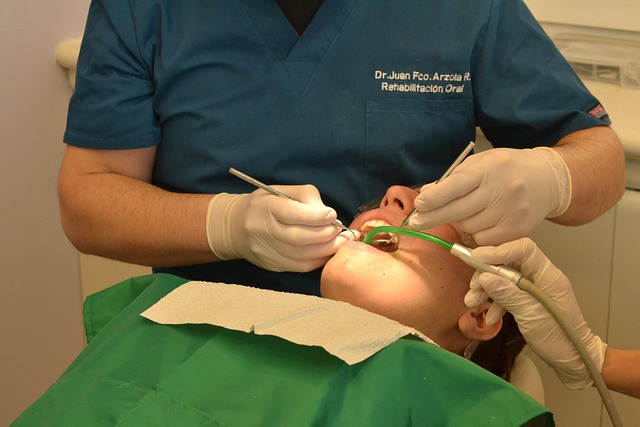McAllen Dentists: Expert Orthodontics & Natural Brace Options

McAllen, Texas, dental offices offer advanced natural orthodontic treatments, including Invisalign a…….
In the realm of oral healthcare, orthodontic treatment has emerged as a transformative process, promising straighter smiles and improved dental alignment. The question “Can I get braces at a McAllen dentist office?” is one that many individuals, especially teenagers and adults seeking to enhance their smile aesthetics, often ponder. This comprehensive article delves into the world of orthodontic care, exploring its availability, benefits, challenges, and future prospects, specifically in the context of McAllen dentist offices. By the end, readers will gain a detailed understanding of how they can access braces within their local dental community and what to expect throughout the treatment journey.
Definition: Orthodontic treatment using braces is a specialized dental procedure aimed at correcting misaligned teeth, bite issues, and malocclusions. Braces work by applying gradual pressure to nudge teeth into their correct positions over time. This process is typically accomplished through the use of metal brackets attached to the teeth, connected by wires, and sometimes enhanced with elastics or other auxiliary tools.
Core Components:
Historical Context: Orthodontic treatments have evolved significantly over the past century. Early attempts at straightening teeth involved functional appliances, such as headgear and mouthguards, which were cumbersome and less effective. The modern orthodontic brace system, characterized by metal brackets and wires, emerged in the mid-20th century and has since become the standard of care for many dental practices worldwide.
Significance: Access to braces through local dentist offices is pivotal for several reasons:
Orthodontic care, particularly brace treatments, has experienced global growth and adoption, driven by several factors:
| Region | Key Factors Influencing Brace Adoption | Notable Trends |
|---|---|---|
| North America | High demand for aesthetic dentistry, advanced technological options, and accessible dental insurance. | Clear aligner therapy (e.g., Invisalign) is gaining popularity, offering a more discreet alternative to traditional metal braces. |
| Europe | Strong focus on preventive dentistry and oral health awareness. Growing acceptance of cosmetic procedures. | Metal braces are still prevalent, with a rise in custom-made, digitally designed brackets for improved aesthetics. |
| Asia Pacific | Rapid urbanization and increasing disposable incomes driving demand for orthodontic services. | A mix of traditional metal braces and innovative clear aligner systems, tailored to cultural preferences and economic factors. |
| Latin America | Growing awareness of oral health and cosmetic procedures, coupled with expanding dental tourism. | Combination treatments offering both aesthetic and functional benefits are gaining traction. |
The economic landscape surrounding orthodontic treatment is multifaceted, involving various stakeholders and market dynamics:
Market Size: The global orthodontic apparatus market was valued at USD 7.2 billion in 2021 and is projected to grow at a CAGR of 6.8% from 2022 to 2030 (Source: Grand View Research). This growth is driven by rising demand for aesthetic dentistry, technological advancements, and expanding access to dental care.
Investment Patterns: Dental practices, including those offering orthodontic services, require significant upfront investments in equipment, software, and staff training. Many providers offer financing options to make these treatments more accessible.
Insurance Coverage: In the United States, for instance, most dental insurance plans cover a portion of orthodontic treatment costs, encouraging more individuals to pursue braces. McAllen dentist offices that accept various insurance plans can attract a broader patient base.
Technological innovations have revolutionized orthodontic care, enhancing precision, efficiency, and patient experiences:
Digital Orthodontics: Computer-aided design (CAD) and computer-aided manufacturing (CAM) technologies enable the creation of custom brackets and appliances, improving treatment outcomes. Digital imaging and 3D printing further enhance accuracy in treatment planning.
Clear Aligner Systems: Invisalign, for example, uses a series of clear, removable aligner trays to gradually move teeth. This technology offers a more comfortable and discreet alternative to metal braces.
Teledentistry: Remote consultations and monitoring via video conferencing have become prevalent, especially during the COVID-19 pandemic. Teledentistry expands access to orthodontic care, particularly in underserved areas.
AI and Machine Learning: These technologies assist in diagnosing malocclusions, predicting treatment outcomes, and personalized treatment planning, potentially reducing treatment time and improving results.
The regulatory environment surrounding dental and orthodontic services varies across regions, impacting access and practice standards:
Licensing and Certification: Dental professionals, including orthodontists, must obtain licenses and certifications to practice in their jurisdictions. These requirements ensure a certain level of competence and safety.
Dental Associations: Professional organizations play a pivotal role in setting standards, providing continuing education, and advocating for oral health policies. In the U.S., the American Dental Association (ADA) sets guidelines for orthodontic treatment.
Reimbursement Policies: Insurance reimbursement rates and regulations influence how much dental practices can charge for orthodontic services. Balancing insurance claims with patient affordability is a critical aspect of running an orthodontic practice.
Despite its numerous benefits, orthodontic treatment faces several challenges and criticisms:
Cost: Braces can be expensive, often requiring multiple visits over several years. Financial constraints may deter individuals from pursuing treatment. Offering payment plans or sliding scale fees can mitigate this challenge.
Treatment Time: Traditional metal braces typically require 18-36 months of active treatment. Patients with busy schedules or those seeking quicker results may find this duration challenging.
Comfort and Side Effects: Some patients experience discomfort, irritation, or headaches during treatment. Orthodontists can provide strategies to alleviate these issues, and modern technologies aim to enhance patient comfort.
Retainer Compliance: After active treatment ends, wearing retainers as prescribed is crucial to maintain results. Neglecting retainer wear can lead to relapse, requiring further treatment.
Case Study 1: Teenager’s Journey to a Straighter Smile
Patient Profile: Sarah, a 16-year-old high school student from McAllen, Texas, had always been self-conscious about her crooked teeth. She sought orthodontic treatment at her local dentist office to improve her smile for college applications and boost her confidence.
Treatment Approach: The dentist recommended clear aligner therapy (Invisalign) due to Sarah’s age and desire for a discreet option. She committed to wearing her aligner trays for 22 hours daily over the next year.
Outcomes: After completing her treatment, Sarah achieved a remarkable transformation, gaining a straighter smile and increased self-esteem. She shared her experience on social media, inspiring others in McAllen to consider orthodontic care.
Case Study 2: Adult Patient’s Transformation
Patient Profile: John, a 35-year-old professional from McAllen, had always wanted braces but avoided them due to time constraints and concerns about appearance during his busy corporate career.
Treatment Solution: His dentist office introduced him to a rapid orthodontic treatment option using ceramic brackets and a shortened treatment timeline. John decided on this alternative due to its aesthetic benefits and shorter duration (12-18 months).
Results: John’s new smile significantly boosted his confidence in social and professional settings. He became an advocate for orthodontic care, sharing his positive experience with colleagues and friends in the local community.
The future of orthodontic treatment holds exciting possibilities, driven by ongoing technological advancements and evolving patient preferences:
Personalized Treatment: AI and genomics may enable more tailored treatment plans, considering individual genetic factors and oral health histories.
Minimally Invasive Techniques: Continued development in clear aligner technology and rapid orthodontic methods will cater to patients seeking quicker, less visible options.
Integration of Telehealth: Virtual consultations and remote monitoring could become even more prevalent, especially for follow-up visits and routine check-ups, further expanding access to care.
Cultural Sensitivity: Orthodontic practices may incorporate cultural considerations in their treatment approaches, recognizing diverse aesthetic preferences and oral health traditions.
“Can I get braces at a McAllen dentist office?” is a question that has gained significant traction in recent years, reflecting growing interest in orthodontic care worldwide. This article has explored the various facets of this topic, from historical perspectives to future trends, highlighting the importance of accessible, high-quality orthodontic treatment. McAllen dentist offices play a vital role in providing these services, enabling individuals to achieve straighter, healthier smiles.
Q: How old do I need to be to get braces?
A: There is no specific age limit for braces. Orthodontic treatment is suitable for both teenagers and adults. The ideal time to consider braces is when there are signs of malocclusion or when a child’s teeth begin to come in improperly, allowing for early intervention.
Q: Are braces painful?
A: While some patients may experience discomfort during treatment, modern orthodontics have significantly reduced pain levels. Orthodontists provide anesthesia and pain management techniques to ensure patient comfort throughout the process.
Q: How long do brace treatments typically last?
A: Treatment duration varies depending on the severity of malocclusion and the chosen treatment method. Metal braces usually require 18-36 months, while clear aligner therapy may take up to 2 years or more.
Q: Do I need to remove my braces to eat?
A: No, you do not have to remove your braces to eat. However, it’s recommended to avoid sticky or hard foods that can dislodge the brackets. Orthodontists provide guidance on a specific diet during treatment to ensure proper nutrition and minimal bracket damage.
Q: How much do braces cost?
A: Brace costs vary widely depending on the treatment method, location, and insurance coverage. On average, metal braces range from $3000 to $5000, while clear aligner therapy can cost between $4000 and $6000 or more. Many dental offices offer financing options to make these treatments more affordable.

McAllen, Texas, dental offices offer advanced natural orthodontic treatments, including Invisalign a…….

Braces, essential for correcting misaligned teeth and jaw issues, offer both health and cosmetic ben…….

McAllen dentist offices provide orthodontic treatment for all ages, including braces options like me…….

McAllen residents can indeed get braces at local dentist offices naturally. Reputable practices offe…….

Dr. Joya Cazares, a top-rated McAllen dentist, offers comprehensive orthodontic care with advanced t…….

Yes, you can get braces at a McAllen dentist office naturally. Modern options like clear aligner tra…….

Preventive dental care, including regular checkups and orthodontic treatment like braces, significan…….

Choosing an orthodontist in McAllen, TX, is crucial for a successful smile transformation. The denta…….

Understanding dental insurance coverage is crucial when considering braces in McAllen. Review your p…….